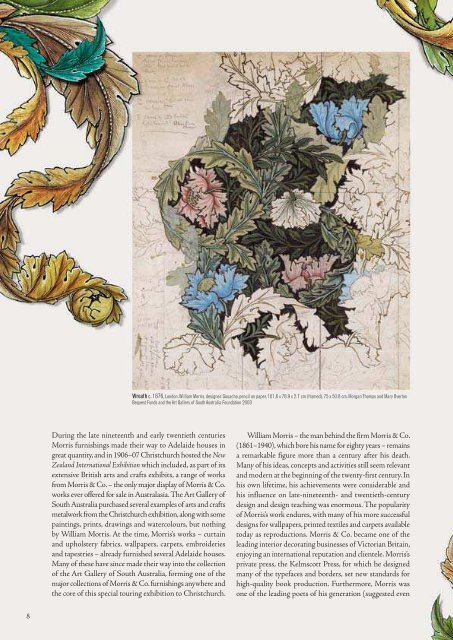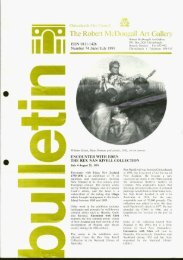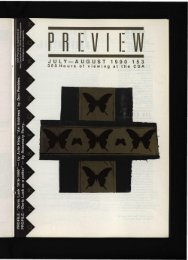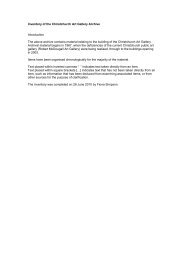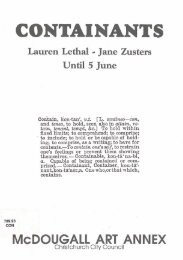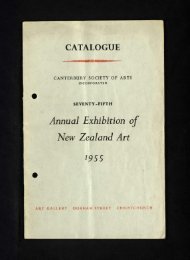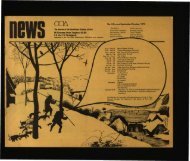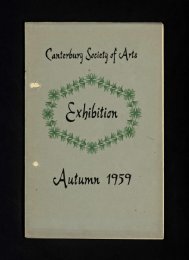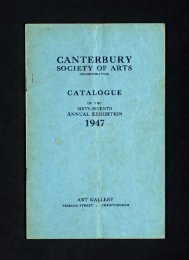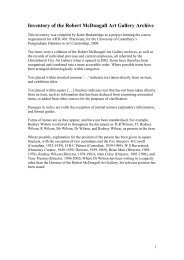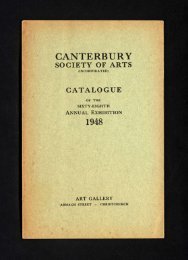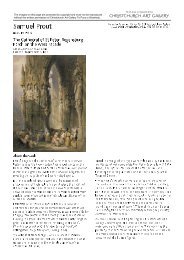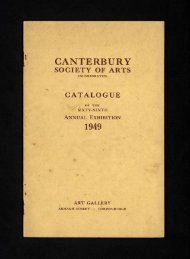Download - Christchurch Art Gallery
Download - Christchurch Art Gallery
Download - Christchurch Art Gallery
Create successful ePaper yourself
Turn your PDF publications into a flip-book with our unique Google optimized e-Paper software.
Wreath c. 1876, London. William Morris, designer. Gouache, pencil on paper, 101.6 x 78.9 x 2.7 cm (framed), 75 x 50.8 cm. Morgan Thomas and Mary Overton<br />
Bequest Funds and the <strong>Art</strong> <strong>Gallery</strong> of South Australia Foundation 2003<br />
During the late nineteenth and early twentieth centuries<br />
Morris furnishings made their way to Adelaide houses in<br />
great quantity, and in 1906–07 <strong>Christchurch</strong> hosted the New<br />
Zealand International Exhibition which included, as part of its<br />
extensive British arts and crafts exhibits, a range of works<br />
from Morris & Co. – the only major display of Morris & Co.<br />
works ever offered for sale in Australasia. The <strong>Art</strong> <strong>Gallery</strong> of<br />
South Australia purchased several examples of arts and crafts<br />
metalwork from the <strong>Christchurch</strong> exhibition, along with some<br />
paintings, prints, drawings and watercolours, but nothing<br />
by William Morris. At the time, Morris’s works – curtain<br />
and upholstery fabrics, wallpapers, carpets, embroideries<br />
and tapestries – already furnished several Adelaide houses.<br />
Many of these have since made their way into the collection<br />
of the <strong>Art</strong> <strong>Gallery</strong> of South Australia, forming one of the<br />
major collections of Morris & Co. furnishings anywhere and<br />
the core of this special touring exhibition to <strong>Christchurch</strong>.<br />
William Morris – the man behind the firm Morris & Co.<br />
(1861–1940), which bore his name for eighty years – remains<br />
a remarkable figure more than a century after his death.<br />
Many of his ideas, concepts and activities still seem relevant<br />
and modern at the beginning of the twenty-first century. In<br />
his own lifetime, his achievements were considerable and<br />
his influence on late-nineteenth- and twentieth-century<br />
design and design teaching was enormous. The popularity<br />
of Morris’s work endures, with many of his more successful<br />
designs for wallpapers, printed textiles and carpets available<br />
today as reproductions. Morris & Co. became one of the<br />
leading interior decorating businesses of Victorian Britain,<br />
enjoying an international reputation and clientele. Morris’s<br />
private press, the Kelmscott Press, for which he designed<br />
many of the typefaces and borders, set new standards for<br />
high-quality book production. Furthermore, Morris was<br />
one of the leading poets of his generation (suggested even<br />
as a successor to Lord Tennyson as Poet Laureate), a strong<br />
and active force in the preservation of historic buildings, an<br />
art and design theorist, a novelist, and an important figure<br />
in the early stages of socialism.<br />
William Morris was born in England in 1834 and died<br />
in 1896. His parents’ wealth gave him a considerable degree<br />
of financial independence, and private means underpinned<br />
his later business ventures. Morris developed an interest in<br />
and taste for historical literature, notably Sir Walter Scott’s<br />
novels, and medieval art early on in his life. His fondness for<br />
the medieval past was part of a nineteenth-century trend<br />
that found inspiration in the art of the Middle Ages. Morris<br />
went to Oxford University in 1853, intending to study for a<br />
career in the church. At Oxford he met Edward Burne-Jones<br />
(1833–98) and the two became firm friends, a friendship and<br />
collaborative artistic partnership lasting to the end of their<br />
lives. Morris and Burne-Jones realised that they were more<br />
interested in careers in art rather than the church. In 1856<br />
Morris was articled to the Gothic revival architect George<br />
Edmund Street (1824–81). Morris remained with Street<br />
for most of that year, but realised he was unsuited to the<br />
profession and abandoned this pursuit. In 1859 he married<br />
the beautiful Jane Burden, whom he had met in Oxford.<br />
The firm Morris, Marshall, Faulkner & Co. was<br />
established in 1861 to bring together variously skilled people<br />
to work in the decorative arts. It had developed out of the<br />
problems Morris faced when furnishing his newly built<br />
house, Red House in Kent, which Philip Webb had<br />
designed for the recently married couple. Morris<br />
had gathered his talented friends around him to<br />
create furnishings that were in a medieval style –<br />
large wooden furniture, painted wall decoration,<br />
embroidered hangings. The success of this<br />
collaborative venture among friends inspired<br />
the creation of the design and manufacturing<br />
business. Morris, Marshall, Faulkner & Co.<br />
gained favourable public recognition at the<br />
London International Exhibition of 1862, and this<br />
success brought the first substantial commissions.<br />
In 1865 the firm moved to Queens Square, and<br />
during the second half of the 1860s the first<br />
major commissions were received.<br />
These included the superb<br />
interiors for St James’s<br />
Palace, London in<br />
Evenlode curtain c. 1925, designed 1883, London. William Morris, designer. Indigo discharge<br />
and colour wood-block print on cotton, 248 x 70 cm (display), 248 x 89 cm. Gift of William & Lili<br />
Manos 1991<br />
Bird Curtain c. 1912, London. William Morris, designer. Woven wool, 268 x 118 cm. Gift of Tom and<br />
Indika Giles 1993<br />
8 9


